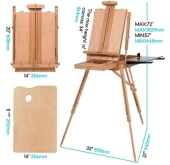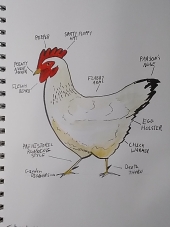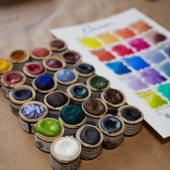




The mark of a true practitioner is not what arises in your life and mind, but how you work with what arises.
Dzigar Kongtrul Rinpoche, “The Path of Patience”
 5
5











 3
3











 3
3




Tereza Okava wrote:hey, no judgment about brushes. you can make great art with kiddie paintbrushes, or your fingers, or chicken feathers.
Zone 6b, dry, high desert in New Mexico 7500' elevation
have you checked your new USDA Hardiness zone? Check here: https://planthardiness.ars.usda.gov/
 4
4




"Also, just as you want men to do to you, do the same way to them" (Luke 6:31)
 7
7




![Filename: 16927281547425005476140430514503.jpg
Description: hmmm, this camera had trouble capturing the colours and it looks washed out. [Thumbnail for 16927281547425005476140430514503.jpg]](/t/220265/a/219911/16927281547425005476140430514503.jpg)







 3
3











 2
2

















 3
3




r ranson wrote:I guess the next thing to ask about is masking fluid. Things like the white spots on the chicken and the eye highlight are really hard to leave out. I ended up having to add the eye highlight after with a white pen.
I don't know what my question is because I don't know anything about masking fluid. Any idea what questions I need to ask to find out if it's right for me?
"Also, just as you want men to do to you, do the same way to them" (Luke 6:31)
 6
6











 5
5




 2
2











 3
3




The mark of a true practitioner is not what arises in your life and mind, but how you work with what arises.
Dzigar Kongtrul Rinpoche, “The Path of Patience”
 3
3




 3
3










 3
3




Flora Eerschay wrote:Also, try painting/drawing from nature, instead of photos. Especially when you're learning. Photo is a view already interpreted, by the camera.
"Also, just as you want men to do to you, do the same way to them" (Luke 6:31)
 3
3




Mar Viega wrote:2 things -
My Grandpa was a plumber - plumber's putty is the best eraser, however I can't find real putty anymore.
I use a razor to carefully, precisely cut to white. Does anyone do this?







 2
2




Flora Eerschay wrote:Also, try painting/drawing from nature, instead of photos. Especially when you're learning. Photo is a view already interpreted, by the camera.













 4
4




r ranson wrote:New question.
Is there some sort of graphite paper that will erase? I want to sketch the design on paper then trace it onto the watercolour block, but the transfer paper I have doesn't erase if I make an error.
"Also, just as you want men to do to you, do the same way to them" (Luke 6:31)
 2
2











 2
2




The mark of a true practitioner is not what arises in your life and mind, but how you work with what arises.
Dzigar Kongtrul Rinpoche, “The Path of Patience”
 3
3




Mar Viega wrote:To R Ranson - what is Japanese putty? I want to try that. I just bought plumber's putty - mistake, crumbly, not malleable like old school








 2
2




Inge Leonora-den Ouden wrote:
r ranson wrote:New question.
Is there some sort of graphite paper that will erase? I want to sketch the design on paper then trace it onto the watercolour block, but the transfer paper I have doesn't erase if I make an error.
When I want to transfer a traced drawing (or something) I don't use carbon paper. I trace on transparent paper (like the kind for sewing patterns), then I trace the lines at the backside with a soft black graphite pencil, I place it (right side up) on the paper where I want it and then trace the lines again with pencil. This will give a soft and erasable transfer.
 2
2

















 2
2




Jenny Wright wrote:...
Yes this or you can just color all over the back of your sketch or picture and then you just trace over the front and the graphite from the pencil on the back will leave a very light outline for you.
"Also, just as you want men to do to you, do the same way to them" (Luke 6:31)
 2
2











 2
2




![Filename: 16933376131641474904568345908898.jpg
Description: [Thumbnail for 16933376131641474904568345908898.jpg]](/t/220265/a/220400/16933376131641474904568345908898.jpg)







 2
2




r ranson wrote:Having trouble deciding the background for the next chicken portrait. So I swatched.
I tried to use mostly colours that will be blended in the chicken, but not too dominant. The blob in the middle is the rough proportions and location of the dominant colours of the chicken.
What's your favourite?
Ps, please ignore the random lines as I was experimenting with transfer paper alternatives.
The mark of a true practitioner is not what arises in your life and mind, but how you work with what arises.
Dzigar Kongtrul Rinpoche, “The Path of Patience”
 8
8











 7
7











 3
3











 3
3




r ranson wrote:How about charcoal and watercolour?
 4
4




 2
2

















 4
4




r ranson wrote:Here I'm trying different textures to see if I can make a texture like feathers.
Any suggestions for more things to try?
"Also, just as you want men to do to you, do the same way to them" (Luke 6:31)
 4
4




All true wealth is biological.
Lois McMaster Bujold
 5
5











 3
3




All true wealth is biological.
Lois McMaster Bujold
 4
4












|
get schwifty. tiny ad:
The new purple deck of permaculture playing cards
https://www.kickstarter.com/projects/paulwheaton/garden-cards
|








